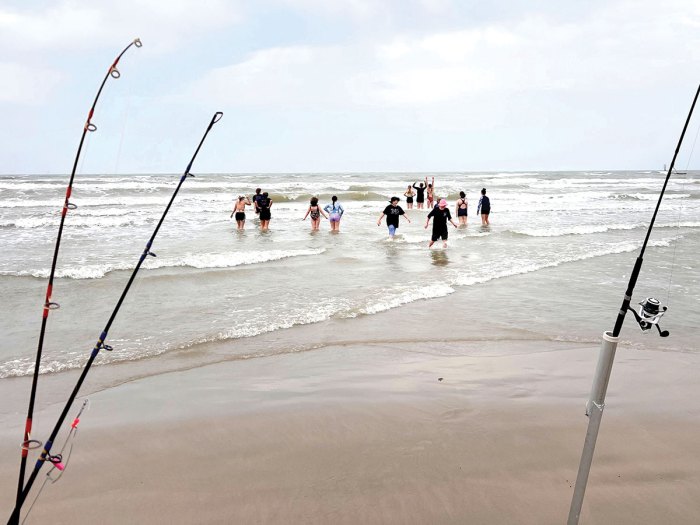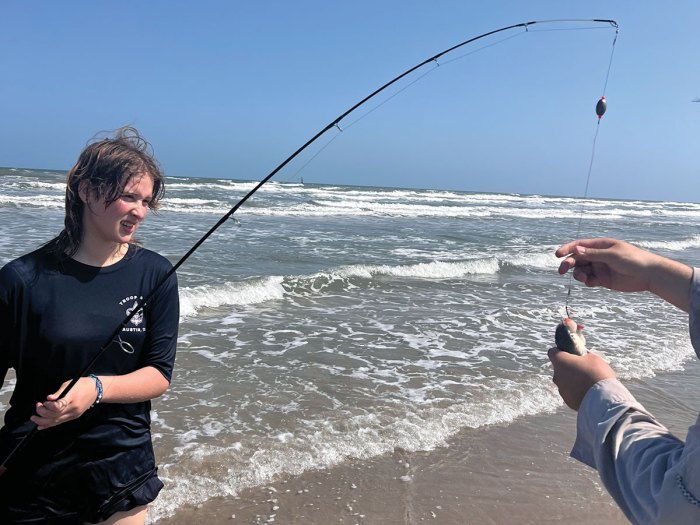Scouts Try Surf Fishing on the Texas Coast

Surf fishing can be much more challenging than dropping a line from the shore of a peaceful lake or river. You’re standing in the water as foamy waves crash around you. You might get a bite and then get nothing. And you wait and wait and wait, but you can’t just stand there.
“You have to keep moving because the waves keep pushing you back,” says Emma Syrdal, 17, a Star Scout. “You have to battle with the waves and the current. And every time you lose your bait, you have to walk all the way back to the beach.”
Overcoming these obstacles and still reeling in fish can be a lot of fun. Troop 4443 of Austin, Texas, found this out during its weekend campout on the Texas coast. The girls caught a few fish, played in the water and capped it all off with a delicious fish fry.

Left: Annabelle Vickery, left, checks out a croaker that Claire Vest reeled in and later released. Right: Emma Syrdal shows off two catfish that she caught.
TO THE COAST
During summer camp a couple of years ago, many of the troop’s Scouts enjoyed taking the Fishing merit badge and wanted to plan their own fishing trip. So last year, they settled on Mustang Island State Park, a place with five miles of beachfront. One of the adult leaders had some of the fishing equipment they would need, and the troop borrowed the rest.
For surf fishing, you need sturdier stuff, like heavy-duty line, bigger weights and stronger rods. Your tackle needs to handle not only pulling in a large fish but also enduring the rough waves and currents. The girls were hoping to land spotted sea trout or red drum, but in case they didn’t, they packed hot dogs and hamburgers. Before they baited their hooks, the Scouts who were classified as swimmers reviewed the safety rules and picked buddies. Then they set up a fishing area away from swimmers.

Left: Not every meal involved seafood. Emily Stone, Ava Lovelace, Emma Syrdal and Addy Heitmann make French toast for breakfast. Right: Emily Stone and Emma Syrdal hold up a fish they caught.
IN THE SURF
The Scouts used shrimp and cut bait (pieces of fish or other seafood); these natural baits work well because their odors attract fish. With their hooks baited, they ventured into the water.
“Most of us were doing it for fun,” says Tenderfoot Scout Addy Heitmann, 13. “A few of us were working on the merit badge. I think a lot of the younger Scouts just wanted to play in the water.”
While maneuvering through the waves was a chore, the biggest challenge was staying focused.
“You reel in a lot of lines and nothing happens,” Emma says. “And it’s hard to tell. But when the top of the rod bends down, and it doesn’t pop up as quickly or as hard, there’s weight on it.”
That’s when you might have a fish. However, during their six-plus hours of surf fishing, nobody reeled in a sea trout or red drum. But most everyone was able to snag at least one fish, mainly catfish or Gulf whiting.

Josephine Ryza gets some help removing a fish from her line. Fishhooks are sharp, so be careful and review your first-aid skills in case you or someone else gets one stuck in their skin.
ON THE PLATE
Many of the fish they caught weren’t very meaty. Still, they didn’t have to abandon their seafood supper. One of the adults had brought red drum, red snapper and mahimahi. The adults grilled and fried the fish while the Scouts prepared the side dishes, including fries, salad, coleslaw and rice.
“It was so good,” says Scout Evie Heitmann, 11.
The fishing trip ranked high for the girls. They tried a favorite activity in a new way and enjoyed it, with most of the troop making the four-hour journey to the coast.
“I really enjoyed this campout,” Addy says. “It was very Scout-y.”
Stay Safe
Before any aquatic activity, review Scouting America’s safety guides, including Safe Swim Defense.
In the ocean, there are added dangers, including jellyfish stings and rip currents. If you’re stung by a jellyfish, you can remove the tentacles and rinse the sting with vinegar. If any swelling worsens or you have an allergic reaction, seek medical help.
If you’re swept out to sea by a rip current, stay calm and swim across the current instead of against it. When you reach calmer waters, you can return to shore.
Being prepared helps you to have a safe and enjoyable trip.
Leave a Comment